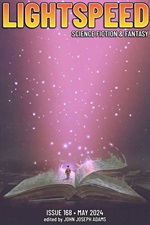“Done Deal” by Rory Harper
“We Will Teach You How to Read | We Will Teach You How to Read” by Caroline M. Yoachim
“Exit Interview” by Ben Peek
“The Last Thing They See Is Laika” by Stephen Geigen-Miller
“And the Dreams That You Dare to Dream” by Marissa Lingen
“Over a Long Time Ago” by Nisi Shawl
“Richard Nixon and the Princess of the Crows” by P H Lee
“Chaos Theory” by Ash Howell
Reviewed by Victoria Silverwolf
Eight stories appear in this issue, mostly on the short side, providing an even balance of science fiction and fantasy.
“Done Deal” by Rory Harper is a brief account of a rock star who makes a deal with the devil in exchange for success. The bargain turns out to be something other than the usual loss of his soul.
This semi-humorous, semi-satiric little tale depends almost entirely on its plot twist. If nothing else, the author provides a sardonic look at the unsavory aspects of the music industry.
The title of “We Will Teach You How to Read | We Will Teach You How to Read” by Caroline M. Yoachim reflects the story’s unusual appearance on the page. The text appears in two parallel columns, one of which repeats the same words multiple times. Towards the end, more complex typographic patterns appear.
This physical structure reflects the story’s content. Aliens who perceive multiple texts simultaneously attempt to instruct humans in this skill, in order to preserve the vanishing culture of the extraterrestrials.
The experimental nature of the text is intriguing on an intellectual level, if not so much on an emotional one. The work is more to be admired as an experimental exercise than to be appreciated as fiction.
The narrator of “Exit Interview” by Ben Peek accepts a job with a mysterious organization after her daughter disappears. Her work involves obtaining magical objects, often from supernatural beings. She finds out that the man who recruited her failed to give her vital information.
This synopsis leaves out the fact that sections of narration alternate with reproductions of forms from the organization, with boxes for the employee to check off relating to job satisfaction. There is also a transcript of a conversation between the woman and the recruiter. These narrative tricks add little to what is otherwise a straightforward dark fantasy story. The forms, in particular, seem unnecessary to the plot, although they may be intended as a satiric look at corporate bureaucracy.
Less than one thousand words long, “The Last Thing They See Is Laika” by Stephen Geigen-Miller is a mood piece about an astronaut in Earth orbit who is stranded after an accident severs his connection to his spacecraft. There is no possibility of rescue, and the astronaut ponders a legend about doomed space travelers as he faces certain death.
The story ends in an ambiguous fashion, with a climax that may be either supernatural or hallucinatory. In either case, this tiny work combines realism with sentimentality in an effective fashion. The title and early parts of the story may give away too much about the conclusion.
The protagonist of “And the Dreams That You Dare to Dream” by Marissa Lingen, unsatisfied with the world, enters a fantasy realm. The place is nice, but the supernatural inhabitants are not as friendly as she would like. Another human living in the magical world offers helpful advice.
This is a quiet, gentle story. The main character has friends in the mundane world, and doesn’t seem terribly unhappy. (There is one tiny hint, barely noticeable, that she is transgendered, but this does not seem to cause her any major problems with other people.) Her desire to be better liked by the magical beings is also a very minor dilemma, with a simple solution.
“Over a Long Time Ago” by Nisi Shawl is the issue’s longest and most complex story. The protagonist is aboard a starship carrying the minds of prisoners, these to be placed in cloned bodies on arrival at another planet. (She has her own consciousness implanted into a duplicate of her dead male lover’s body.) An accident causes multiple systems to break down. During her desperate struggle to save the ship and its passengers, with the aid of an artificial intelligence in the form of a simulacrum of herself, she discovers a startling truth.
This is an overly simplified synopsis of a story with multiple speculative elements and an intricate back story that is not always entirely clear. (An interview with the author makes it clear that this is part of a series, which may explain some of my confusion.) The author skillfully portrays a future much different from our own time. Much of the impact comes from the conclusion; readers may find that it renders the rest of the story less than meaningful.
In “Richard Nixon and the Princess of the Crows” by P H Lee, the elderly former President confronts talking crows. The birds ask him to undertake a quest to rescue their monarch. The ex-President discovers an extraordinary fact about himself.
If the main character were entirely fictional rather than an imaginary version of Nixon, this would be a typical tale of fantasy. As far as I can tell, the intent is neither humorous nor satiric, so the use of the disgraced President as the protagonist seems to be nothing more than a gimmick.
In “Chaos Theory” by Ash Howell, genetically modified, artificially grown workers stage a bloodless rebellion against their creators. To say anything else would be to give away too much about a story that is less than one thousand words long. Suffice to say that the main speculative premise, revealed late in the text, may be overly familiar to some readers.
Victoria Silverwolf is still working a lot of extra days.
 Lightspeed
Lightspeed